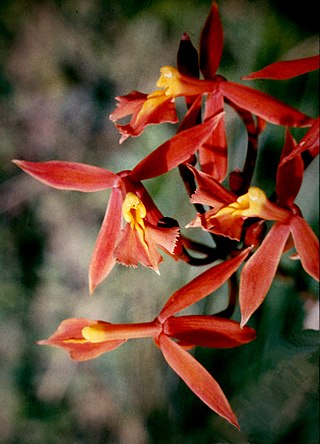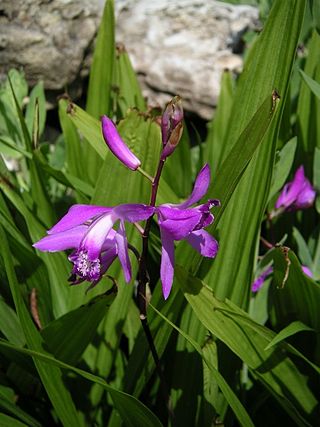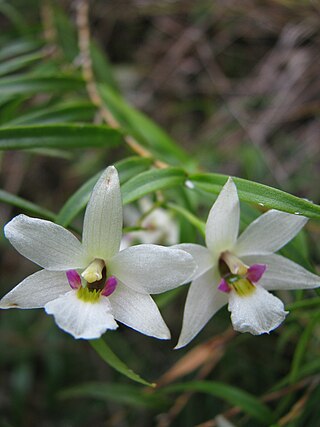Related Research Articles

A cactus is a member of the plant family Cactaceae, a family comprising about 127 genera with some 1750 known species of the order Caryophyllales. The word cactus derives, through Latin, from the Ancient Greek word κάκτος (káktos), a name originally used by Theophrastus for a spiny plant whose identity is now not certain. Cacti occur in a wide range of shapes and sizes. They are native to the Americas, ranging from Patagonia in the south to parts of western Canada in the north, with the exception of Rhipsalis baccifera, which is also found in Africa and Sri Lanka. Cacti are adapted to live in very dry environments, including the Atacama Desert, one of the driest places on Earth. Because of this, cacti show many adaptations to conserve water. For example, almost all cacti are succulents, meaning they have thickened, fleshy parts adapted to store water. Unlike many other succulents, the stem is the only part of most cacti where this vital process takes place. Most species of cacti have lost true leaves, retaining only spines, which are highly modified leaves. As well as defending against herbivores, spines help prevent water loss by reducing air flow close to the cactus and providing some shade. In the absence of true leaves, cacti's enlarged stems carry out photosynthesis.

Orchids are plants that belong to the family Orchidaceae, a diverse and widespread group of flowering plants with blooms that are often colourful and fragrant.

In botany, a bulb is structurally a short stem with fleshy leaves or leaf bases that function as food storage organs during dormancy.

An epiphyte is a plant or plant-like organism that grows on the surface of another plant and derives its moisture and nutrients from the air, rain, water or from debris accumulating around it. The plants on which epiphytes grow are called phorophytes. Epiphytes take part in nutrient cycles and add to both the diversity and biomass of the ecosystem in which they occur, like any other organism. They are an important source of food for many species. Typically, the older parts of a plant will have more epiphytes growing on them. Epiphytes differ from parasites in that they grow on other plants for physical support and do not necessarily affect the host negatively. An organism that grows on another organism that is not a plant may be called an epibiont. Epiphytes are usually found in the temperate zone or in the tropics. Epiphyte species make good houseplants due to their minimal water and soil requirements. Epiphytes provide a rich and diverse habitat for other organisms including animals, fungi, bacteria, and myxomycetes.

Dendrobium is a genus of mostly epiphytic and lithophytic orchids in the family Orchidaceae. It is a very large genus, containing more than 1,800 species that are found in diverse habitats throughout much of south, east and southeast Asia, including China, Japan, India, the Philippines, Indonesia, Australia, New Guinea, Vietnam and many of the islands of the Pacific. Orchids in this genus have roots that creep over the surface of trees or rocks, rarely having their roots in soil. Up to six leaves develop in a tuft at the tip of a shoot and from one to a large number of flowers are arranged along an unbranched flowering stem. Several attempts have been made to separate Dendrobium into smaller genera, but most have not been accepted by the World Checklist of Selected Plant Families.

Vegetative reproduction is any form of asexual reproduction occurring in plants in which a new plant grows from a fragment or cutting of the parent plant or specialized reproductive structures, which are sometimes called vegetative propagules.

A perennial plant or simply perennial is a plant that lives more than two years. The term is often used to differentiate a plant from shorter-lived annuals and biennials. The term is also widely used to distinguish plants with little or no woody growth from trees and shrubs, which are also technically perennials.

Aerial roots are roots above the ground. They are almost always adventitious. They are found in diverse plant species, including epiphytes such as orchids (Orchidaceae), tropical coastal swamp trees such as mangroves, banyan figs, the warm-temperate rainforest rata, and pohutukawa trees of New Zealand. Vines such as common ivy and poison ivy also have aerial roots.

Epidendroideae is a subfamily of plants in the orchid family, Orchidaceae. Epidendroideae is larger than all the other orchid subfamilies together, comprising more than 15,000 species in 576 genera. Most epidendroid orchids are tropical epiphytes, typically with pseudobulbs. There are, however, some terrestrials such as Epipactis and even a few myco-heterotrophs, which are parasitic upon mycorrhizal fungi.

Griselinia is a genus of seven species of shrubs and trees, with a highly disjunct distribution native to New Zealand and South America. It is a classic example of the Antarctic flora. It is the sole genus in the family Griseliniaceae. In the past it was often placed in Cornaceae but differs from that in many features.

Bletilla, common name urn orchid, is a temperate, terrestrial genus of orchids containing five currently recognized species distributed through China, Japan, Taiwan, south to Vietnam, Thailand and Myanmar. The name is actually a diminutive of Bletia because of the resemblance between the two genera even though Bletia is a New World genus. The genera JimensiaRaf. and PolytomaLour. ex Gomes are generally included into Bletilla. This genus is abbreviated Ble in trade journals.

Dendrobium cunninghamii, commonly known as winika, pekapeka, Christmas orchid, bamboo orchid or ladies slipper orchid, is a species of epiphytic orchids that is endemic to New Zealand. It is commonly found growing in rainforest in the North, South, Stewart and Chatham Islands and normally flowers in summer and early autumn.
This page provides a glossary of plant morphology. Botanists and other biologists who study plant morphology use a number of different terms to classify and identify plant organs and parts that can be observed using no more than a handheld magnifying lens. This page provides help in understanding the numerous other pages describing plants by their various taxa. The accompanying page—Plant morphology—provides an overview of the science of the external form of plants. There is also an alphabetical list: Glossary of botanical terms. In contrast, this page deals with botanical terms in a systematic manner, with some illustrations, and organized by plant anatomy and function in plant physiology.
This glossary of botanical terms is a list of definitions of terms and concepts relevant to botany and plants in general. Terms of plant morphology are included here as well as at the more specific Glossary of plant morphology and Glossary of leaf morphology. For other related terms, see Glossary of phytopathology, Glossary of lichen terms, and List of Latin and Greek words commonly used in systematic names.

A stem is one of two main structural axes of a vascular plant, the other being the root. It supports leaves, flowers and fruits, transports water and dissolved substances between the roots and the shoots in the xylem and phloem, stores nutrients, and produces new living tissue. The stem can also be called halm or haulm or culms.

In plant morphology, thorns, spines, and prickles, and in general spinose structures, are hard, rigid extensions or modifications of leaves, roots, stems, or buds with sharp, stiff ends, and generally serve the same function: physically deterring animals from eating the plant material.

Plectorrhiza, commonly known as tangle orchids, is a genus of three species of flowering plants from the orchid family, Orchidaceae and is endemic to Australia. Orchids in the genus Plectorrhiza are epiphytic or lithophytic herbs with short stems, long, tangled roots, short leathery leaves and small flowers on a short, thin flowering stem. Two species occur in eastern Australia and one is endemic to Lord Howe Island.
Plectorrhiza erecta , commonly known as the upright tangle orchid, is an epiphytic or lithophytic orchid that has many coarse, cord-like roots, many bright green leaves and up to five yellowish orange, cup-shaped flowers with purplish blotches. It grows close to the ground on fibrous barked plants and only occurs on Lord Howe Island.
Drymoanthus minutus, commonly known as green midget orchid, is a species of epiphytic or lithophytic orchid that forms small clumps with many thick roots emerging from a thin, erect stem. Between two and five dark green, leathery leaves are arranged along the stem and up to seven minute green to yellowish, star-shaped flowers are arranged on a stiff flowering stem. The sepals and petals are similar to each other and there is a fleshy white, unlobed labellum. This orchid occurs in northern Queensland where it grows in rainforest, usually at higher altitudes.
Saccolabiopsis rectifolia, commonly known as the tiny pitcher orchid, is an epiphytic orchid from the family Orchidaceae. It has a short stem, thin roots, between three and six crowded leaves and up to fifteen cup-shaped green flowers with a white, purple spotted labellum. It grows on the thinnest outer branches of rainforest trees in tropical North Queensland, Australia.
References
- 1 2 3 Subaerial in the Merriam-Webster dictionary.
- ↑ Robert L. Bates, Julia A. Jackson, Dictionary of Geological Terms AGI (1984)
- ↑ Macgregor Skene. Biology of Flowering Plants, page 2. ed. Discovery Publishing House, New Delhi, reprinted in 2006. ISBN 81-7141-205-X.
- ↑ R.H.V. Corley & P.B.H. Tinker. The Oil Palm, 4th edition, page 37. Blackwell Science, 2003 (three eds. in 1967, 1977 and 1988).
- ↑ Macgregor Skene, op. cit., p. 229.
- ↑ Macgregor Skene, op. cit., p. 71.
- ↑ [ dead link ]"Subaerial Stem Modifications" on tutorvista.com.
- ↑ Macgregor Skene, op. cit., p. 294.